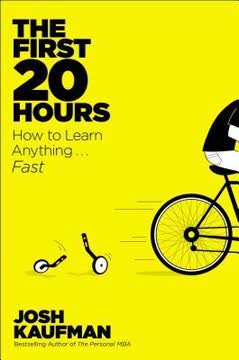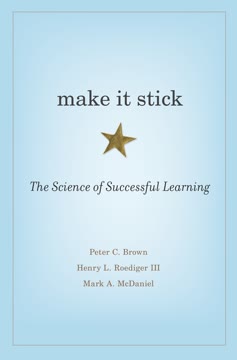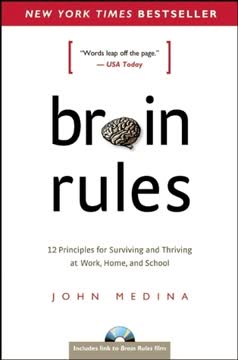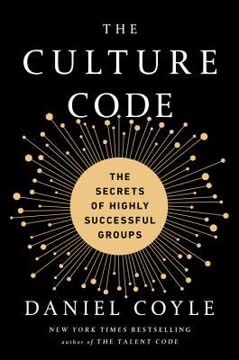Key Takeaways
1. Talent is not innate - it's built through deep practice
Talent begins with brief, powerful encounters that spark motivation by linking your identity to a high-performing person or group.
Deep practice transforms. The key to developing talent is not genetic gifts, but rather engaging in deep, focused practice that pushes you to the edge of your abilities. This type of practice literally changes your brain, building new neural connections that enhance skill. The talent hotbeds studied by the author all shared a culture of intensive, purposeful practice.
Deep practice elements:
- Chunking skills into manageable pieces
- Repetition with a focus on improvement
- Embracing struggle and mistakes
- Operating at the edge of your current abilities
By understanding that talent is built, not born, we can approach skill development with a growth mindset that fuels motivation and perseverance.
2. Ignite motivation by connecting to role models
We each live with a "windshield" of people in front of us; one of the keys to igniting your motivation is to fill your windshield with vivid images of your future self, and to stare at them every day.
Visualize your ideal future. Motivation is sparked when we can see ourselves in the shoes of high performers. By regularly exposing yourself to inspiring role models in your field, you create a visceral connection to your potential future self. This ignites an unconscious drive to bridge the gap between your current and idealized self.
Ways to connect with role models:
- Watch videos of top performers in action
- Read biographies of masters in your field
- Seek out mentors or coaches
- Surround yourself with images of excellence
Creating this "windshield" of inspiration keeps you motivated during the challenging process of skill development.
3. Break skills into chunks and practice at the edge of your ability
Every skill is built out of smaller pieces—what scientists call chunks.
Master the fundamentals. Complex skills are built by mastering smaller, component skills. By breaking down a skill into its fundamental chunks, you can focus your practice more effectively. The key is to identify the smallest elements you can master, then gradually combine them into larger, more complex movements.
Chunking process:
- Analyze the skill to identify core components
- Practice individual chunks in isolation
- Gradually combine chunks into larger sequences
- Continually refine and adjust
Practice should occur at the edge of your current ability - in the "sweet spot" where you're challenged but not overwhelmed. This is where the most rapid skill development occurs.
4. Embrace struggle and make mistakes to grow
Deep practice has a telltale emotional flavor, a feeling that can be summed up in one word: "struggle."
Struggle signals growth. The discomfort you feel when practicing at the edge of your abilities is actually a sign of progress. This struggle indicates that you're forming new neural connections and expanding your capabilities. Instead of avoiding mistakes, view them as valuable feedback that guides your improvement.
Strategies for productive struggle:
- Set challenging but achievable goals
- Focus on the process, not just outcomes
- Analyze mistakes to identify areas for improvement
- Celebrate effort and progress, not just results
By reframing struggle as a necessary part of growth, you can push through discomfort and accelerate your skill development.
5. Slow down to speed up skill acquisition
To learn a new move, exaggerate it.
Practice with precision. Counter-intuitively, slowing down your practice can actually speed up your overall progress. By practicing movements slowly and deliberately, you can more easily identify and correct errors in technique. This builds a stronger foundation of proper form, which ultimately allows for faster and more fluid execution.
Slow practice techniques:
- Exaggerate movements to highlight key elements
- Use mental imagery to visualize perfect form
- Practice in slow motion, gradually increasing speed
- Break complex movements into micro-movements
Remember, the goal is to build correct neural pathways. Speed will naturally follow as these pathways become more efficient through repetition.
6. Use vivid imagery and visualization to enhance learning
Whenever possible, create a vivid image for each chunk you want to learn. The images don't have to be elaborate, just easy to see and feel.
Think in pictures. The human brain is wired to process and remember visual information more effectively than abstract concepts. By associating vivid mental images with the skills you're learning, you can accelerate the learning process and improve retention.
Visualization techniques:
- Create mental movies of perfect skill execution
- Use metaphors to link new skills to familiar concepts
- Imagine the physical sensations associated with the skill
- Visualize success in high-pressure situations
Combining physical practice with mental imagery exercises can dramatically enhance your rate of skill acquisition.
7. Create a daily practice routine with frequent, short sessions
With deep practice, small daily practice "snacks" are more effective than once-a-week practice binges.
Consistency trumps intensity. Regular, focused practice sessions are more effective for skill development than occasional long sessions. This approach aligns with how our brains learn and grow - through consistent stimulation and reinforcement of neural pathways.
Elements of an effective practice routine:
- Set a consistent daily practice time
- Keep sessions short (15-30 minutes) but focused
- Prioritize quality of practice over quantity
- Use a practice journal to track progress
By making practice a daily habit, you create momentum that compounds over time, leading to significant skill improvements.
8. Develop soft skills through varied, game-like practice
Soft skills are about the three Rs: Reading, Recognizing, and Reacting.
Play to learn. Soft skills, such as decision-making and social interaction, are best developed through varied, engaging practice that mimics real-world scenarios. By turning practice into games or simulations, you can create an environment that's both challenging and enjoyable.
Strategies for soft skill development:
- Create scenarios that require quick decision-making
- Practice with partners to simulate real interactions
- Use role-playing exercises to explore different perspectives
- Analyze case studies to improve pattern recognition
The key is to create practice situations that require you to actively read situations, recognize patterns, and react appropriately - just as you would in real-life applications of the skill.
9. Cultivate grit and a growth mindset for long-term success
Developing talent is like taking a cross-country hike. You will encounter challenges; you will hit snags, plateaus, and steep paths; motivation will ebb and flow.
Persistence pays off. Long-term success in any skill requires more than just practice - it demands resilience and a belief in your ability to improve. Cultivating grit - the ability to persevere through challenges - and maintaining a growth mindset are crucial for overcoming inevitable setbacks and plateaus.
Ways to build grit and a growth mindset:
- Set long-term goals and break them into manageable steps
- Celebrate effort and progress, not just achievements
- Reframe failures as learning opportunities
- Seek out challenges that push you beyond your comfort zone
Remember that skill development is a journey, not a destination. Embracing this mindset helps you stay motivated and committed to continuous improvement.
10. Teach others to deepen your own understanding
When you communicate a skill to someone, you come to understand it more deeply yourself.
Learn by teaching. One of the most effective ways to solidify your own understanding of a skill is to teach it to others. This process forces you to break down complex concepts, articulate your knowledge clearly, and often leads to new insights about the skill.
Benefits of teaching:
- Deepens your own understanding
- Identifies gaps in your knowledge
- Improves your ability to communicate complex ideas
- Reinforces fundamental concepts
Look for opportunities to mentor others or explain concepts to peers. This not only accelerates your own learning but also contributes to a positive learning community.
Last updated:
FAQ
What's "The Little Book of Talent" about?
- Nonfiction guide: "The Little Book of Talent" by Daniel Coyle is a nonfiction book that provides practical tips for improving skills across various disciplines.
- 52 tips: The book is structured around 52 tips that are designed to help readers develop their talents through effective practice and motivation.
- Talent development: It explores the concept that talent is not innate but can be developed through deliberate practice and the right mindset.
- Research-based insights: The book draws on research from talent hotbeds and scientific studies to offer actionable advice.
Why should I read "The Little Book of Talent"?
- Practical advice: The book offers concise, actionable tips that can be easily integrated into daily routines to improve skills.
- Broad applicability: Whether you're an athlete, musician, student, or professional, the tips are designed to be applicable across various fields.
- Motivational insights: It provides insights into how motivation and mindset play crucial roles in skill development.
- Scientific backing: The advice is grounded in scientific research, making it reliable and effective.
What are the key takeaways of "The Little Book of Talent"?
- Talent is developed: Talent is not solely a genetic gift but can be cultivated through practice and motivation.
- Deep practice: Engaging in focused, deliberate practice is essential for skill improvement.
- Mindset matters: A growth mindset, where challenges are embraced and mistakes are seen as learning opportunities, is crucial.
- Role of repetition: Repetition is a powerful tool for building and strengthening neural pathways.
What are the best quotes from "The Little Book of Talent" and what do they mean?
- "We are what we repeatedly do. Excellence, then, is not an act, but a habit." This quote emphasizes the importance of consistent practice in achieving excellence.
- "Think like a gardener, work like a carpenter." It suggests that skill development requires patience and strategic effort, much like nurturing a plant or building a structure.
- "Practice makes myelin, and myelin makes perfect." This highlights the role of myelin in skill acquisition, where practice strengthens neural pathways.
- "Embrace struggle." It encourages readers to see struggle as a necessary part of the learning process, leading to growth and improvement.
How does "The Little Book of Talent" define talent?
- Not innate: Talent is not an inherent trait but something that can be developed through effort and practice.
- Combination of practice and motivation: Talent is determined by the combination of intensive practice and motivation that leads to brain growth.
- Ignition: The book introduces the concept of ignition, where motivation is sparked by linking one's identity to a high-performing person or group.
- Skill development: Talent involves building and refining skills through deliberate practice and learning from mistakes.
What is the "sweet spot" in "The Little Book of Talent"?
- Edge of ability: The sweet spot is the zone where you learn best, right on the edge of your current abilities.
- 50-80% success rate: It is characterized by a success rate of 50-80%, where you are fully engaged and slightly challenged.
- Mistakes as guideposts: Mistakes are frequent but serve as guideposts for improvement, helping to build new neural connections.
- Creative practice methods: Finding the sweet spot may involve creative practice methods, such as slowing down or playing backward, to stretch abilities.
What is "deep practice" according to "The Little Book of Talent"?
- Focused effort: Deep practice involves focused, deliberate effort aimed at improving specific skills.
- Reaching and repeating: It requires operating on the edge of your ability, reaching for targets just out of reach, and repeating actions to strengthen neural pathways.
- Mistake-driven learning: Embracing mistakes as opportunities to learn and improve is a key component.
- Engagement and feedback: Deep practice is immersive and involves receiving strong, speedy feedback to guide progress.
How does "The Little Book of Talent" suggest improving motivation?
- Ignition moments: Create ignition moments by linking your identity to high-performing individuals or groups to spark motivation.
- Role models: Stare at who you want to become by observing top performers and using them as role models.
- Positive framing: Focus on positive reaches and what you want to achieve, rather than what you want to avoid.
- Keep goals secret: Keeping big goals to yourself can prevent premature satisfaction and maintain motivation.
What is the "R.E.P.S. gauge" in "The Little Book of Talent"?
- Reaching and Repeating: Ensures practice involves operating on the edge of ability with frequent repetitions.
- Engagement: Practice should be immersive and command attention, using emotion to propel toward goals.
- Purposefulness: Tasks should directly connect to the skills you want to build, ensuring relevance and effectiveness.
- Strong, Speedy Feedback: Provides immediate, accurate information about performance to guide improvement.
How does "The Little Book of Talent" differentiate between hard and soft skills?
- Hard skills: These are precise, repeatable actions that require consistent execution, like a golf swing or math calculations.
- Soft skills: These involve flexibility and adaptability, requiring pattern recognition and decision-making, like improvisation or negotiation.
- Different methods: Hard skills are developed through careful, slow practice, while soft skills benefit from playful, exploratory practice.
- Skill combination: Most talents involve a mix of both hard and soft skills, requiring different approaches for development.
What role does myelin play in skill development according to "The Little Book of Talent"?
- Insulation for neural pathways: Myelin wraps around neural pathways, making signals faster and more efficient.
- Growth through practice: Myelin grows in response to practice, with more layers added through repeated actions.
- Irreversible process: Once myelinated, pathways cannot be unwrapped, highlighting the importance of building correct habits.
- Lifelong potential: Myelin can continue to grow throughout life, allowing for skill development at any age.
What strategies does "The Little Book of Talent" offer for overcoming plateaus?
- Change practice methods: Disrupt autopilot by altering practice methods, such as speeding up, slowing down, or reversing tasks.
- Focus on sweet spot: Ensure practice remains in the sweet spot, where learning is most effective.
- Shift perspectives: Use different angles or approaches to challenge existing skills and encourage growth.
- Embrace struggle: Recognize that struggle is a natural part of the learning process and a sign of progress.
Review Summary
The Little Book of Talent receives mostly positive reviews, with readers praising its concise, practical advice for skill development. Many appreciate the book's straightforward approach, offering 52 tips for improving talents across various fields. Readers find the tips memorable and applicable to daily life. Some criticize the lack of depth, while others appreciate its brevity. The book is seen as a valuable resource for anyone looking to enhance their skills, with particular emphasis on its usefulness for coaches, teachers, and students.
Similar Books










Download PDF
Download EPUB
.epub digital book format is ideal for reading ebooks on phones, tablets, and e-readers.







